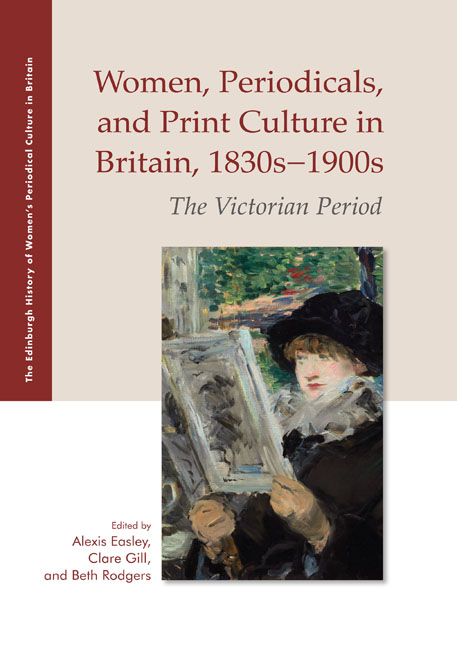Book contents
- Frontmatter
- Contents
- List of Illustrations
- Acknowledgments
- Introduction: Women, Periodicals, and Print Culture in the Victorian Period
- Part I (Re)Imagining Domestic Life
- Part II Constructing Modern Girls and Young Women
- Part III Women and Visual Culture
- Women and Visual Culture: Introduction
- 13 Vicarious Pleasures: Photography, Modernity, and Mid-Victorian Domestic Journalism
- 14 Beauty Advertising and Advice in the Queen and Woman
- 15 Women of the World: The Lady's Pictorial and Its Sister Papers
- 16 Rewriting Fairyland: Isabella Bird and the Spectacle of Nineteenth-Century Japan
- 17 Victorian Women Wood Engravers: The Case of Clemence Housman
- Part IV Making Space for Women
- Part V Constructing Women Readers and Writers
- Part VI Intervening in Political Debates
- Notes on Contributors
- Index
- Plate section
14 - Beauty Advertising and Advice in the Queen and Woman
from Part III - Women and Visual Culture
Published online by Cambridge University Press: 25 October 2019
- Frontmatter
- Contents
- List of Illustrations
- Acknowledgments
- Introduction: Women, Periodicals, and Print Culture in the Victorian Period
- Part I (Re)Imagining Domestic Life
- Part II Constructing Modern Girls and Young Women
- Part III Women and Visual Culture
- Women and Visual Culture: Introduction
- 13 Vicarious Pleasures: Photography, Modernity, and Mid-Victorian Domestic Journalism
- 14 Beauty Advertising and Advice in the Queen and Woman
- 15 Women of the World: The Lady's Pictorial and Its Sister Papers
- 16 Rewriting Fairyland: Isabella Bird and the Spectacle of Nineteenth-Century Japan
- 17 Victorian Women Wood Engravers: The Case of Clemence Housman
- Part IV Making Space for Women
- Part V Constructing Women Readers and Writers
- Part VI Intervening in Political Debates
- Notes on Contributors
- Index
- Plate section
Summary
MARGARET BEETHAM HAS likened women's magazines to corsets in that each can serve as an ‘instrument of control and source of pleasure’ (1991: 163). This sense of competing ideologies – between demarcating the bounds of acceptable femininity and enabling a range of fantasies – is especially visible in English women's fashion magazines in the late nineteenth century. In this period, women's magazines transformed substantially: first, because there was a ‘great increase’ in the number of magazines published (Fraser et al. 2003: 171), and second, because of the increased prominence and visual appeal of the advertisements they contained. Though advertising was relatively common in women's magazines, as Beetham and Kay Boardman note, it was not until the 1880s that advertisements began to occupy a greater proportion of each issue and to break out from endpapers and supplements to be interspersed with editorial content (2001: 5). The Queen (1861–1958), for example, which is one of the two periodicals considered in this chapter, gave up half of its pages to advertising by the mid-1880s. Advertising also became more visually spectacular in the late Victorian period, with increasing depictions of products and illustrations of idealised women serving as models to entice the reader to purchase a growing number of brandname beauty products.
In this chapter, I consider how these feminine expectations relating to sexuality and cosmetic advertising and advice were mutually reinforcing. Hilary Fraser, Stephanie Green, and Judith Johnston point out that women's magazines hosted ‘important debates about class and gender,’ but that these ‘were often displaced into discussions relating to the apparently trivial and ephemeral world of fashion’ (2003: 1). In the late Victorian period, the work of femininity, as it was constructed in many illustrated women's magazines, became increasingly tied to knowledge about, purchase of, and correct usage of a variety of consumer goods that might be broadly termed beauty products. Nevertheless, women's fashion magazines were infused with contradictory impulses. In their editorial content, women's magazines often maintained traditional views about the subjects of beauty, cosmetics, and women's dress, frequently advocating ‘natural’ beauty and home-made cosmetics, yet at the same time these magazines relied upon promotion of an extensive variety of beauty commodities and introduced the notion of the beauty regimen.
- Type
- Chapter
- Information
- Women, Periodicals and Print Culture in Britain, 1830s–1900sThe Victorian Period, pp. 218 - 231Publisher: Edinburgh University PressPrint publication year: 2019

